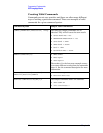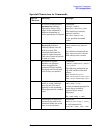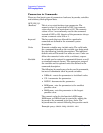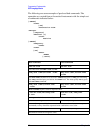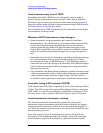
66 Chapter 2
Programming Fundamentals
SCPI Language Basics
The following are some examples of good and bad commands. The
examples are created from a theoretical instrument with the simple set
of commands indicated below:
[:SENSe]
:POWer
[:RF]
:ATTenuation 40dB
:TRIGger
[:SEQuence]
:EXTernal [1]
:SLOPe
POSitive
[:SENSe]
:FREQuency
:STARt
:POWer
[:RF]
:MIXer
:RANGe
[:UPPer]
Bad Command Good Command
PWR:ATT 40dB POW:ATT 40dB
The short form of POWER is POW, not PWR.
FREQ:STAR 30MHz;MIX:RANG -20dBm FREQ:STAR 30MHz;POW:MIX:RANG
-20dBm
The MIX:RANG command is in the same :SENSE subsystem as FREQ, but executing
the FREQ command puts you back at the SENSE level. You must specify POW to get to
the MIX:RANG command.
FREQ:STAR 30MHz;POW:MIX RANG
-20dBm
FREQ:STAR 30MHz;POW:MIX:RANG
-20dBm
MIX and RANG require a colon to separate them.
:POW:ATT 40dB;TRIG:FREQ:STAR
2.3GHz
:POW:ATT 40dB;:FREQ:STAR
2.3GHz
:FREQ:STAR is in the :SENSE subsystem, not the :TRIGGER subsystem.
:POW:ATT?:FREQ:STAR? :POW:ATT?;:FREQ:STAR?
:POW and FREQ are within the same :SENSE subsystem, but they are two separate
commands, so they should be separated with a semicolon, not a colon.
:POW:ATT -5dB;:FREQ:STAR 10MHz :POW:ATT 5dB;:FREQ:STAR 10MHz
Attenuation cannot be a negative value.





